
A few months ago, I posted $HOOD's (fools?) gold (and potential matching shenanigans!). The premise was simple: a lot of people had pinged me on Robinhood’s new (at the time) gold membership program (if you don’t have a Robinhood account / membership, here’s a referral code that gets you (and me!) a free share with sign up). The gold membership costs ~$5/month but it came with a ton of benefits, including a credit card with unreal cash back terms (3% cash back), a 3% match for rolling over an IRA, and improved cash sweep.
Anyway, it’s been a few months, and I’ve been an active (and happy) gold member, so I wanted to throw some thoughts down just because I find the offer and space so interesting.
Why do I find it so interesting?
If you’ll recall the original article, the thing that fascinated me about HOOD is that they were offering rewards that no one else came close to matching. To chose two examples, they’re offering 3% matches on new IRA money, and they’re offering 3% cash back rewards on the HOOD gold card. Those matches / cash back are far, far above what peers are offering; I could be mistaken, but (outside of a few small peers) I’m not aware of anyone who offers any money for IRA transfers, and the 3% cash back on the credit card is far, far above almost every card I’m aware of.
So I find HOOD so interesting because how you view their generous offers is something of a Rorschach test on how you view HOOD:
An optimist / bull might look at HOOD’s generous offers and say it actually aligns with financial history. Large financial institutions can grow fat on bureaucracy, complacency, and regulatory burdens; the combination makes it really difficult for them to respond to changes in technology, which creates an opening every decade or so for a new competitor to come along, dramatically undercut the legacy players on cost, and take tons of share. Think of Schwab and the discount brokerages in the 70s, or etrade and online native brokerages taking share in the 90s. Under this light, you might look at Robinhood and think something like “legacy players have been slow to respond to what modern savers / traders want, and by utilizing tech and a leaner structure Robinhood can take share and make money in the same way disruptors of previous years did”
If you’re a pessimist / bear, you might note that Robinhood is growing fast. A classic rule in finance is “beware a fast growing financial”. Fast growing financials tend to be the scariest thing in finance, because rapid growth can mask a lot of problems in the underlying business (particularly in lending, but it can also paper over other deficiencies….)…. but when the growth inevitably slows (often due to just the law of large numbers making each incremental dollar worth less in terms of growth), those previous errors can come back to catch the company all at once.
A pessimist would also point something else out: it’s not like the people Robinhood is competing against are complete idiots. For example, look at credit cards. Robinhood seems to be having a ton of success by combining Robinhood Gold membership (which costs $5/month) with the Robinhood credit card (which gives 3% cash back). I think one of the most popular cards is the Chase Sapphire Reserve (could be biased; it’s been my main card for ~10 years! But it is generally rated as one of the best premium rewards cards; here’s a referral link if you want to try it). The Sapphire costs $550/year (so almost 10x the annual cost of a Robinhood Gold membership) and basically gives you 1% cash back (though you get a lot more for travel spend and there are a ton of other benefits). JP Morgan (who issues the sapphire) is a behemoth of a financial institution, and they offer every financial product under the sun. It’s not like it would be hard for them to launch a 3% cash back card if they thought the math would work, and you’d think they’d have to have tried to run the math now that Robinhood has done it and grabbed hundreds of thousands of consumers….. so the fact JPM hasn’t launched a similar card would suggest they don’t think a card can be profitable at this level of rewards.
Of course, a counter to the pessimist would be the big banks always have the resources to match what an upstart is doing…. and yet over the years they’ve failed to respond as Schwab and Capital One both grew huge undercutting them and cherry picking the best customers.
I have no horse in this race (i.e. I’m not long any of the stocks here)1, but I am just so interested in that “HOOD Rorschach” test and I do think how HOOD develops / plays out over the next few years could have a big impact on a lot of things in the financial space (i.e. if HOOD works, a lot of big players are going to have to offer much more generous rewards to compete) that I’ve been following their earnings / conference appearances reasonably closely. So I wanted to just provide some updated thoughts on HOOD and how they appear to be thinking about the economics behind their offers / promotions (and, of course, if you follow the space and think I’m missing something or see something else interesting, I’d love to hear it!).
I’m going to spend the majority of this article just showing quotes from how HOOD is talking about their initiatives and the returns on them. But I want to lead off with three specific discussion points:
The credit card program / I still can’t believe these terms
HOOD’s willingness to experiment
HOOD stock curiosity
Let’s start with the first: the credit card program. If you read the first piece, I realize I’m harping on this…. but I just don’t understand how HOOD is making a profit on this program. No one else is even close to offering 3% cash back, and that includes players like Amex (who owns the payment network and thus should be extra incentivized to get you over their rails) or Fidelity (who also offering brokerage accounts!). Heck, SoFi is a pretty direct comp to HOOD, and their credit card is 2.2% cash back in total (2% cash back plus another 10% if you have direct deposit2).
So I remain really skeptical that HOOD is making a profit on this card…. but HOOD is pretty consistent that the early results are really strong, and it’s driving great results for them:
The other area I think is interesting with HOOD is experimentation. It came to me when I saw the exchange below and particularly the line “you’re the only major brokerage that offers a full crypto offering”
HOOD’s presidential election market bets would probably fall into this “experimentation” bucket as well.
So what’s the line of thinking here? Upfront, I mentioned how the big finance players get really old / slow and make room for a new competitor every decade or so. I wonder if HOOD being the only major brokerage to offer crypto and presidential election betting3 is another sign that the sleepy brokerages have left an opening for them to build out a major new competitor; I mean, if you’re trading a brokerage account and into crypto, why wouldn’t you want to have the two in the same place? What is it that makes HOOD the only person to offer that combo? Perhaps there’s some regulatory burden or risk I’m unaware of, but it seems to me HOOD being the only one to offer the combo is damning on their peers’ sleepiness.
So those were the two big questions running through my head with HOOD. Let’s quickly turn to the stock. I’m really interested in HOOD for a bunch of reasons, but I do think the stock is interesting. As I write this, it’s got a ~$21B market cap with ~$5B in cash on the balance sheet (and that’s ignoring the cash they hold for their customers). It’ll do ~$1B in EBITDA this year, and they’ve just started returning capital to shareholders through share buybacks.
There are tons of holes you could point in the stats I just threw out. In particular, you’d probably note that the $1B in EBITDA is an adjusted number and they do ~$1B in stock comp per year. But just stick with me for a second: there’s reason to think HOOD’s earnings are dramatically understated. The company is growing fast. In Q3, gold subs were up ~65% YoY, they’re launching the HOOD credit card, and overall investment accounts were up ~6%. Growth is expensive for a business like HOOD; grabbing a new user generally takes a pretty high customer acquisition cost (something like a deposit match, which I’ll discuss later / HOOD thinks they’re getting a great return on!).
The headline number is that HOOD is trading for something like 15-20x EBITDA…. that’s not bad for a company growing >30% YoY and attacking an enormous market. But I think if you really looked at the growth and thought about the growth costs, you could envision a world where HOOD is trading a lot cheaper than that while growing pretty spectacularly.
Again, I have no deep thoughts on HOOD. I’m just watching it because I could so opportunity here at some point. But those are the major thoughts I’ve had when thinking about HOOD. I’m going to spend the rest of this post just clipping some highlights on their strategy from their recent earnings and conference appearances; no firm takeaways from me, I just find the company and strategy fascinating.
Let’s start by focusing on HOOD’s foray into the gold membership and all these products: they clearly think the early returns suggest they’ve stumbled onto a winner. The CEO is talking about the gold subscription creating a “powerful flywheel” for cross sell that’s spinning faster and faster as it evolves:
And the flywheel potential seems pretty interesting; not only is HOOD getting the $5/month subscription fee, but they’re getting 7x the ARPU from gold members and gold members are 5x more likely to “adopt retirement”.
Now, I do wonder about selection bias in that group, but overall it does seem pretty interesting / like the returns are there.
Speaking of returns, I’ve been pretty skeptical on the returns from all of their promotions just because they seem so much more generous than peers….
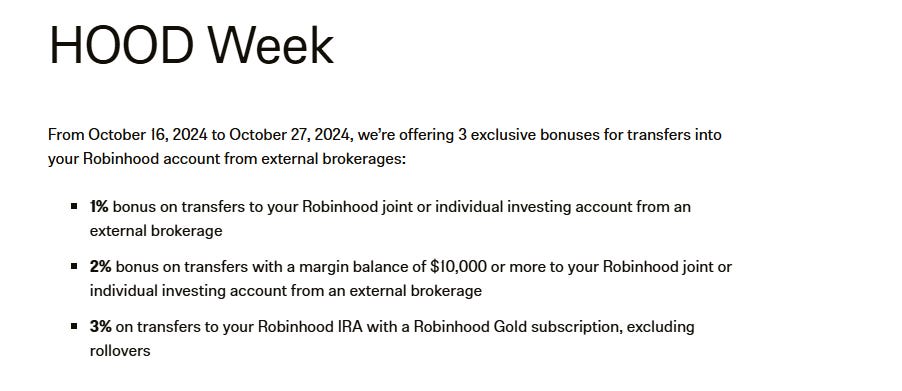
And it even seems like they can be easily gamed. Consider that margin bonus; I had several people email me something like “why don’t I just buy $10.1k of treasuries on margin and then transfer my account”. If you hypothetically did that on a $100k account, that would boost your transfer bonus from 1 to 2% and create an extra $1k in match bonus (disclaimer: margin is risky, not investing advice, see our legal disclaimer, etc.).
So I’m skeptical of those promos and their returns given they can be gamed and seem far more generous than anything else I’ve seen…. but HOOD clearly thinks they’re seeing good returns on all their promotions. For example, they think the payback period on all of their matches is “relatively quick”, with ~1 year payback on 1% matches and ~3 years for 3% retirement matches.
I also think there’s another good sign for shareholders: HOOD stopped offering 1% deposit matches because the math suggested it wasn’t creating much value. That they found some matches that didn’t meet their IRR hurdles and shut them down gives at least some credence to the view that GOOD is actually measuring the returns on these (and shutting down bad returns) and not just throwing around money like crazy.
The commentary around their credit card is also interesting. Again, the big worry with HOOD is that they’re offering a 3% cash back credit card, and no one else is coming close to offering that. So you’re worried they’re having huge adverse selection, and they’re taking in a pool of customers that will turn out to be super unprofitable.
The good news here is that HOOD seems to have been trying to go slow with the credit card and confirm that the economics would work for them before going crazy and opening it up to everyone:
Alright, I’m going to wrap it up here. I’ll end by noting this: I’m no financials expert…. but I do see some pattern recognition and some interesting potential at HOOD. I’ll probably never own the stock…. but who knows? Maybe one day something will click and I’ll pull the trigger, and until then I’m a happy customer and an intrigued onlooker.
I guess I can disclose that I have a Robinhood account / gold membership / gold card!
Here’s a SOFI referral if you really want to try them out too
I think IBKR offers both as well!

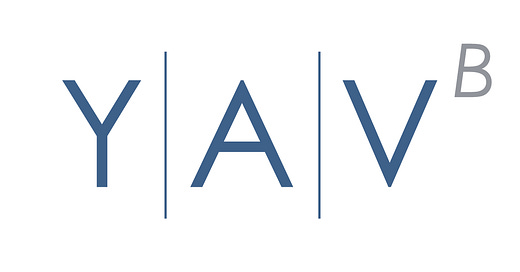


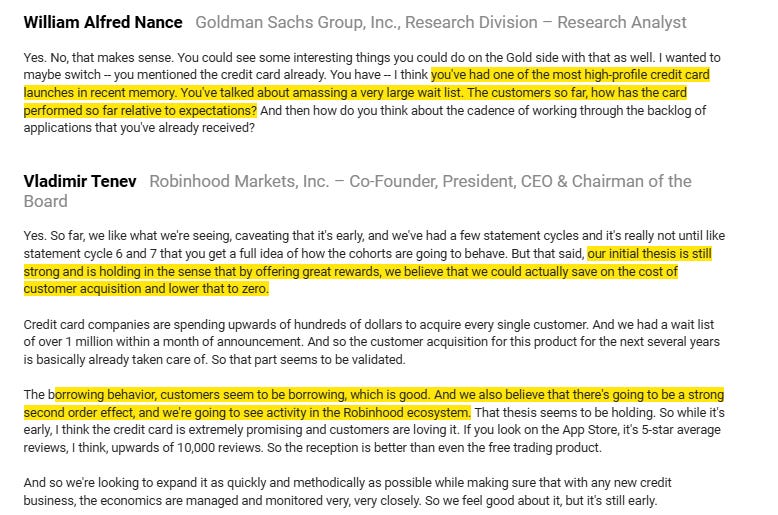
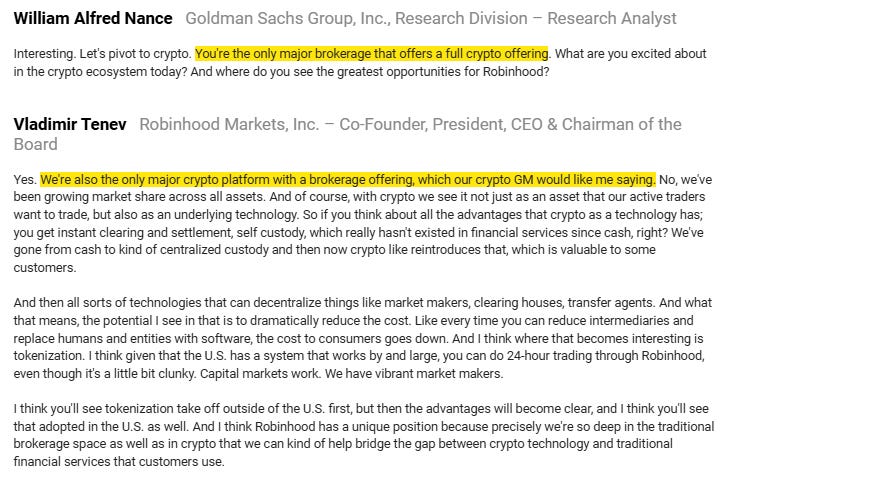
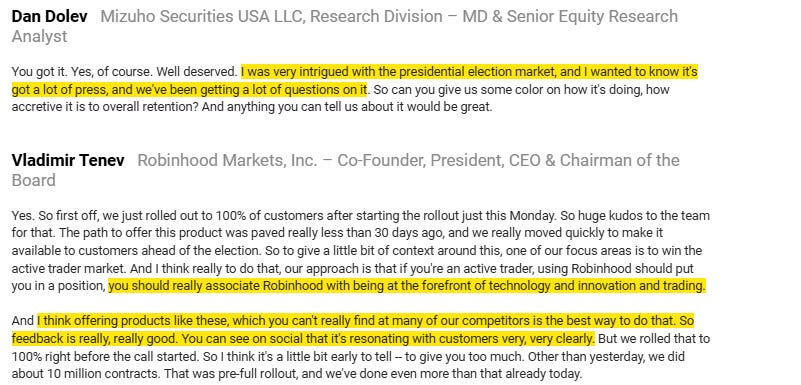
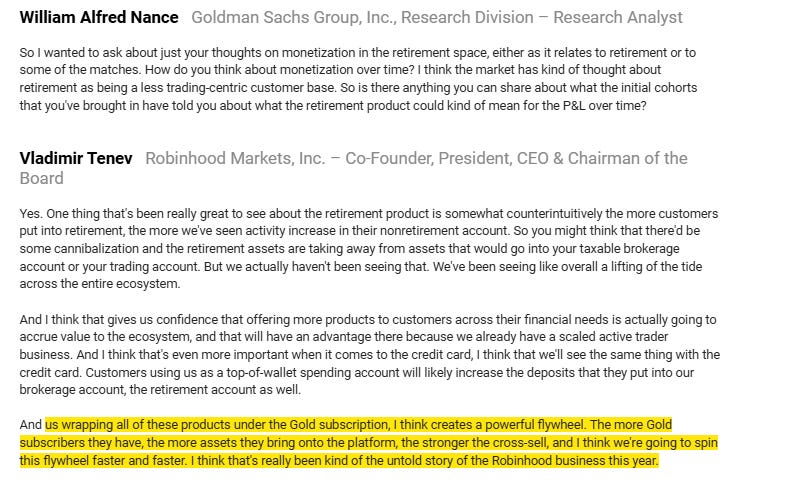
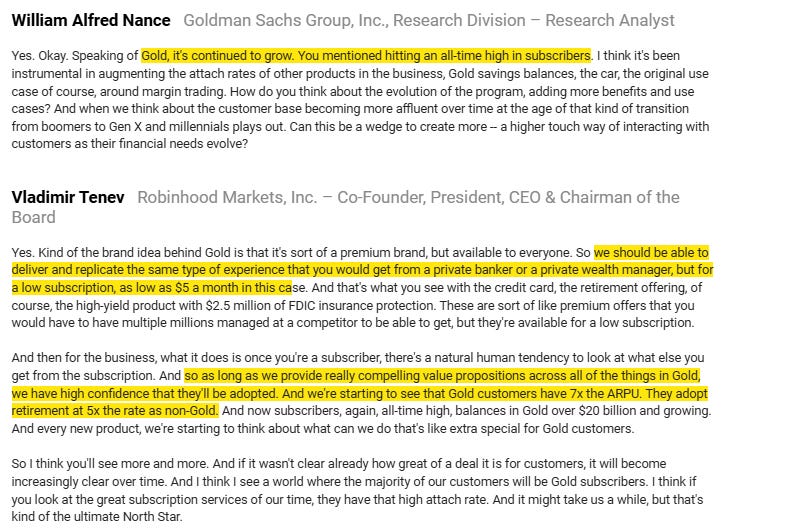


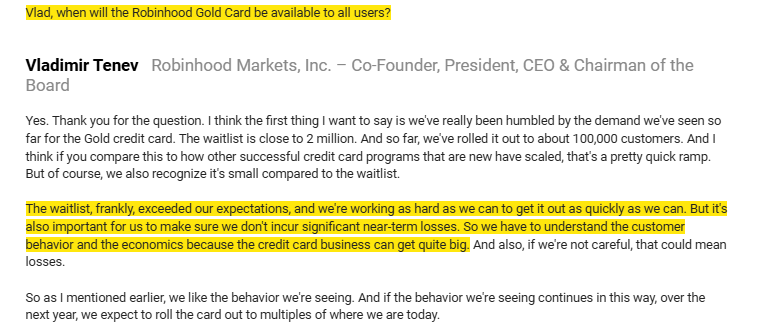
I have and love this card for legit personal expenses, but they are aggressive at flagging and rejecting most forms of manufactured spending including MS that is routinely accepted by JPM/V and others.
The scuttlebutt has been that the Sapphire Reserve has lost money for JPM every year it's been around: that's why the past few years have nerfed benefit after benefit (removing Priority Pass restaurants, where every swipe cost JPM around $20, being the latest). Similar is true for the Citi card (no longer offered to new applicants) that tried to come at the Amex Platinum.